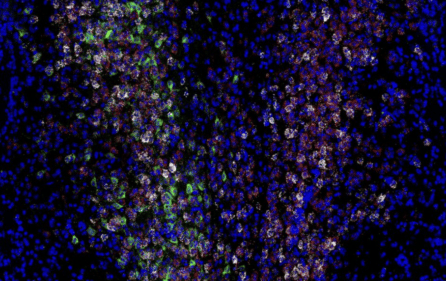Good Memory or Bad Memory? How Your Brain Decides.
NewsThe Context: Associating memories with good and bad feelings is something we do daily without a second thought. However, scientists have been working hard to discern how the brain is able to assign positive or negative feelings to certain memories, and how this may play a role in disorders where this process is overactive such as anxiety, depression, and post-traumatic stress disorder (PTSD).
The Study: A signaling molecule called neurotensin is responsible for determining whether memories become associated with a positive or negative feeling, found a study published in Nature from the lab of NYSCF – Robertson Neuroscience Investigator Alumna Kay Tye, PhD, of the Salk Institute. Dr. Tye compares neurotensin to the switch operator of a set of train tracks, controlling whether a memory takes the positive or negative track.
The Importance: Learning more about how positive and negative feelings are assigned, as well as the role of neurotensin and its receptors in this process, can lead to new therapies for treating disorders like anxiety, depression, or PTSD.
When was the last time you remembered an upsetting event and felt sad, or recalled a fun day and felt happy? We do this all the time, but how exactly our brains make it possible has been unknown.
“How do you put the fear aside for a moment and learn about something positive? And what switches you into that brain state? All of those things were mysterious before,” noted Dr. Tye in an article in STAT.
Thanks to advances in gene editing and techniques for studying neuron behavior, that is no longer the case.
“We’ve basically gotten a handle on the fundamental biological process of how you can remember if something is good or bad,” continued Dr. Tye in an article from the Salk Institute.
Connecting Feelings And Memories
How do we know that the experience of eating our favorite food is positive while stepping on a Lego brick is anything but?
Six years ago, Dr. Tye and colleagues found a partial answer. In a study published in 2016, researchers explored the relationship between memory and emotion in mice. They first taught mice to associate different auditory tones with either the presentation of a sweet or bitter-flavored substance.
The team then took a closer look at the mouse brains to understand how hearing the different tones triggered either a positive or negative feeling, referred to as ‘valence.’ They found that certain neurons in the basolateral amygdala (BLA) — a structure located deep within the brain that helps with emotion processing — were more active when the mice heard the sugar-associated tone, while another set of BLA neurons were more excited when the mice heard the bitter-associated tone.
“We found these two pathways — analogous to railroad tracks — that were leading to positive and negative valence, but we still didn’t know what signal was acting as the switch operator to direct which track should be used at any given time,” said Dr. Tye.
A Small Molecule Makes Big Decisions
In this latest study, Dr. Tye’s lab tackled the ‘valence-assignment problem.’ We know that valence assignment occurs and is associated with subsets of neurons in the BLA, but how is the positive and negative association determined? The team suspected that the answer may lie with a molecule called neurotensin that is a known player in valence processing.

Using mice once again, researchers played a tone, then provided the mice with sugar. A second tone was followed by a mild electric shock.
To test their hypothesis, the researchers used gene editing to eliminate neurotensin from BLA neurons. As a result, positive valence — that is the probability that the mice responded to the first tone by eating the sugar — was impaired. Mice didn’t seek out their sweet reward after the associated tone. What was more fascinating was that negative valence was strengthened, meaning the mice became more fearful when played the second, shock-associated tone.
Conversely, when neurotensin was increased in BLA neurons, positive valence was strengthened. The probability that mice consumed the sugar after hearing the first tone was heightened. As one would expect, response to the shock-associated tone was weaker compared to regular neurotensin levels.
To Dr. Tye, this makes sense. To survive, we need to be biased toward fear – to default to taking that first, negative valence railroad track. But when we encounter something positive, we need an extra player (neurotensin) to tell our brains to head down that other railroad track – the one that forms a positive valence.
Therapeutic Opportunities
Scientists believe that neurotensin may be over-activating positive valence assignment in disorders like addiction and over-activating negative valence assignment in depression or PTSD. Dr. Tye’s team will continue to study neurotensin to perhaps one day leverage it for treating these disorders.
“We can actually manipulate this switch [neurotensin] to turn on positive or negative learning,” said co-first author Hao Li, a postdoctoral fellow in Dr. Tye’s lab. “Ultimately, we’d like to try to identify novel therapeutic targets for this pathway.”
Journal Article:
Neurotensin orchestrates valence assignment in the amygdala
Hao Li, Praneeth Namburi, Jacob M. Olson, Matilde Borio, Mackenzie E. Lemieux, Anna Beyeler, Gwendolyn G. Calhoon, Natsuko Hitora-Imamura, Austin A. Coley, Avraham Libster, Aneesh Bal, Xin Jin, Huan Wang, Caroline Jia, Sourav R. Choudhury, Xi Shi, Ada C. Felix-Ortiz, Verónica de la Fuente, Vanessa P. Barth, Hunter O. King, Ehsan M. Izadmehr, Jasmin S. Revanna, Kanha Batra, Kyle B. Fischer, Laurel R. Keyes, Nancy Padilla-Coreano, Cody A. Siciliano, Kenneth M. McCullough, Romy Wichmann, Kerry J. Ressler, Ila R. Fiete, Feng Zhang, Yulong Li and Kay M. Tye. Nature. 2022. DOI: 10.1038/s41586-022-04964-y
Cover image: Kay Tye and Hao Li. Credit: Salk Institute